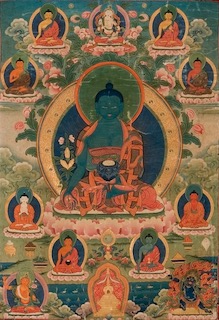Buddha of Medicine

Buddha of Medicine (Skt. Buddha Bhaiṣajya-guru; Tib. སངས་རྒྱས་སྨན་བླ་, Sangyé Menla, Wyl. sangs rgyas sman bla) is an important buddha in the Mahayana tradition, whose main initial vow as a bodhisattva was to become able to completely free all sentient beings from their illnesses.
In the Tibetan Kangyur, there are three sutras primarily concerned with the Buddha of Medicine. One sets forth the twelve aspirations of the Buddha of Medicine, another sets forth the aspirations of the seven other buddhas of medicine, and the third is a very short sutra which sets forth the dharanis or mantras of the various buddhas of medicine.[1] Also, he is central to the Four Medical Tantras, which are the basis of Tibetan medicine, and to many sadhanas of healing.
When the Buddha of Medicine appears as a deity in sadhanas of healing, because deities are a means of communication, the form or appearance of each deity reflects the different activities which they embody and in which they engage, and are determined by the aspirations they made at the time of their initial generation of bodhichitta.
In the case of the Buddha of Medicine there is a specific set of twelve aspirations that relate to his primary motivation to remove the physical and mental suffering of beings in general, but primarily mental and physical illness caused through imbalance of the elements.[2]
A Note on the Name
Within the Buddhist scriptures the Buddha of Medicine is called Bhaishajya-Guru or Vaidurya-prabha-raja (Skt. Vaiḍūrya-prabhā-rāja; Tib. bai dUrya ’od kyi rgyal po). ‘Buddha of Medicine’ is a non-literal meaning translation of his actual Sanskrit name. Bhaishajya-Guru literally translates as ‘Master of Medicine’ and Vaidurya-prabha-raja[3] as ‘Radiant Lapis Lazuli King’.
Names of the seven other buddhas of medicine
Buddha Bhaiṣajya-guru has seven accompanying buddhas in his retinue. One of these is Buddha Shakyamuni.
- Excellent Name (Tib. མཚན་ལེགས་, Tsen Lek, Wyl. mtshan legs)
- Appearance of Stainless Fine Gold (Tib. གསེར་བཟང་དྲི་མེད་སྣང་བ་ , Ser Zang Drimé Nangwa, Wyl. gser bzang dri med snang ba)
- Glorious Supreme One Free from Sorrow (Tib. མྱ་ངན་མེད་མཆོག་དཔལ་, Nya Ngen Mé Chok Pal , Wyl. mya ngan med mchog dpal)
- Melodious Proclamation of Dharma (Tib. ཆོས་བསྒྲགས་དབྱངས་ , Chö Drak Yang, Wyl. chos bsgrags dbyangs)
- King of Clear Knowing (Tib. མངོན་མཁྱེན་རྒྱལ་པོ ་, Ngön Khyen Gyalpo, Wyl. mngon mkhyen rgyal po)
- King of Melodious Sound (Tib. སྒྲ་དབྱངས་རྒྱལ་པོ་ , Drayang Gyalpo, Wyl. sgra dbyangs rgyal po)
- King of the Shakyas (Tib. ཤཱ་ཀྱའི་རྒྱལ་པོ་ , Shakyé Gyalpo , Wyl. shA kya’i rgyal po)
References
- ↑ Thrangu Rinpoche, Medicine Buddha Teachings, Snow Lion Publications ISBN 1-55939-216-9, page 105.
- ↑ Thrangu Rinpoche, Medicine Buddha Teachings, Snow Lion Publications ISBN 1-55939-216-9, pages 105-117.
- ↑ Vaiḍūrya-prabhā-rāja literally implies ‘a king who radiates with the colour of lapis lazuli.’
Transmissions Given to the Rigpa Sangha
- 1979, London, Dzogchen Orgyen Chö Ling, Thrangu Rinpoche—empowerment
- 13 or 14 September 1980, Pagode de Vincennes, Paris, France, Dudjom Rinpoche—empowerment
- 29 August 1999, Amsterdam, Dr Trogawa Rinpoche—empowerment
- 16 September 2000, London, Dr Trogawa Rinpoche—empowerment
- 6 June 2010, Murnau, Germany, Sogyal Rinpoche—oral transmission of prayer & mantra
- 1 August 2014, Lerab Ling, His Holiness Sakya Trizin—empowerment
- 24 May 2015, Dharma Mati, Berlin, Germany, Khamtrul Rinpoche, Dokhampa Shedrub Nyima—empowerment
Tibetan Texts
- Derge Kangyur, vol.87, ff.274r-283v., Wyl. 'phags pa bcom ldan 'das sman gyi bla bai DUR+Ya'i 'od kyi sngon gyi smon lam gyi khyad par rgyas pa zhes bya ba theg pa chen po'i mdo
- 'phags pa de bzhin gshegs pa bdun gyi sngon gyi smon lam gyi khyad par rgyas pa zhes bya ba theg pa chen po'i mdo
- 'phags pa de bzhin gshegs pa'i ting nge 'dzin gyi stobs bskyed pa bai DUR+Ya'i 'od ces bya ba'i gzungs
Further Reading
- Tulku Thondup, Boundless Healing (Shambhala: Boston, 2001), Part Three, Chapter Eight: 'Meditation on the Healing Buddha', pages 131-171
Internal Links
External Links
 The Detailed Account of the Previous Aspirations of the Seven Thus-Gone Ones
The Detailed Account of the Previous Aspirations of the Seven Thus-Gone Ones A Mantra for Incanting Medicines When Administering Them
A Mantra for Incanting Medicines When Administering Them The Profound Cure (Zabchema), Medicine Buddha Practice by Karma Chakme
The Profound Cure (Zabchema), Medicine Buddha Practice by Karma Chakme Sādhana of Bhaiṣajya by Karma Chakme
Sādhana of Bhaiṣajya by Karma Chakme Fast Track to Happiness & Peace by Jamyang Khyentse Wangpo
Fast Track to Happiness & Peace by Jamyang Khyentse Wangpo- Shenpen Osel Issue 9
- Shenpen Osel Issue 10
- Himalayan Art block prints of seven Medicine Buddhas